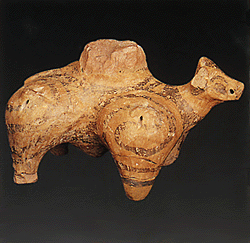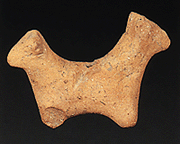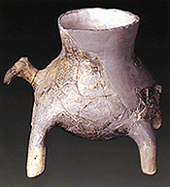 
Zoomorphic figurines form one of the most representative classes of Neolithic figurine art. In these the farming and stock-rearing character of the Neolithic economy is reflected, since in their majority they depict domesticated animal species, such as sheep and goats, cattle, pigs and dogs. More rarely they depict wild animals, mainly deer, bear and boar, water birds, frogs, tortoises and snakes. The better known specimens originate from Eastern Macedonia and Thessaly and date from all the periods of the Neolithic. In southern Greece and the Peloponnese they appeared only during the Late Neolithic. Zoomorphic figurines are in their overwhelming majority manufactured from clay, while rare specimens of stone, bone and sea-shell are also encountered. In all cases they are schematized, for this reason it is difficult to identify them with a specific animal species. The ones made of clay were manufactured from solid masses of clay, and only in exceptional cases with the technique of hollow casting. They are encountered unpainted and burnished, while often the craftsmen depicted anatomical details of animals with painted bands or incisions, in accordance with the model used in vase decoration. Smaller figurines are 2,5-4 centimetres high while larger ones are taller than 20 centimetres. |


Among the animal figurines, independent, twin-headed, attached to vases or house models, but also integral zoomorphic vases have been distinguished. In two cases pregnant animals have been identified, while a clay pig head served to decorate the facade of a house model. |
|
Independent figurines could according to their manufacture either stand freely or be hung by a rope from a hole pierced in them vertically or horizontally. Zoomorphic vases could be used in special cases, as in the example at Platia Magoula Zarkou in Thessaly, where a goat-shaped vase contained the cremated bones of an infant (Late Neolithic). |